Pambamarca 2009, The Field School, Week 3
[ Vacation Diaries ] [ Pambamarca 2009 ] [ Previous Page ] [ Next Page ]
Sunday, July 5, 2009, Hacienda Guachala, Ecuador, about 1500 ECT
(GMT -6)
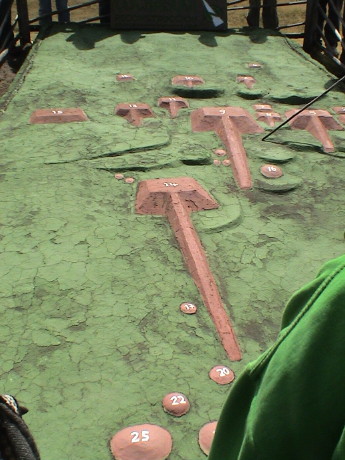 Today, the group took a
field trip to Cochasqui, a site with pre-Inka terraced pyramids. it is
not known exactly what went on on these flat topped pyramids, but the
reasons could be ceremonial, religious, astrological or just about
anything else. The existing structures just look like dirt mounds now
with an obvious ramp leading up to one edge. This is what we are
looking for at Loma Sandoval but our site has been modified by
bulldozer in recent times and doesn't stand out nearly so clearly.
Today, the group took a
field trip to Cochasqui, a site with pre-Inka terraced pyramids. it is
not known exactly what went on on these flat topped pyramids, but the
reasons could be ceremonial, religious, astrological or just about
anything else. The existing structures just look like dirt mounds now
with an obvious ramp leading up to one edge. This is what we are
looking for at Loma Sandoval but our site has been modified by
bulldozer in recent times and doesn't stand out nearly so clearly.
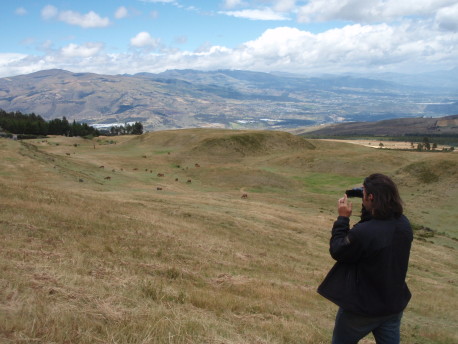 The shapes of the pyramids are
still pretty clear, even after 500 years. Most of them have nothing
inside, all the action apparently happened on top. A few have burial
chambers in them. There are also many older rounded burial mounds on
the site.
The shapes of the pyramids are
still pretty clear, even after 500 years. Most of them have nothing
inside, all the action apparently happened on top. A few have burial
chambers in them. There are also many older rounded burial mounds on
the site.
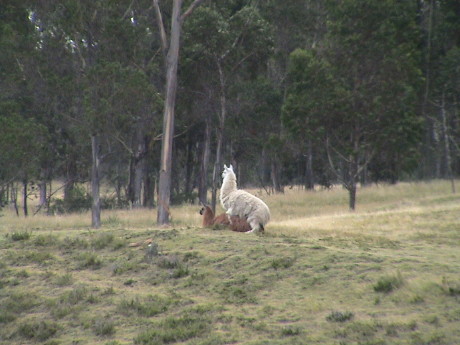 The site is also well
stocked with llama and this is the reason why. These two are busy
making little llamas.
The site is also well
stocked with llama and this is the reason why. These two are busy
making little llamas.
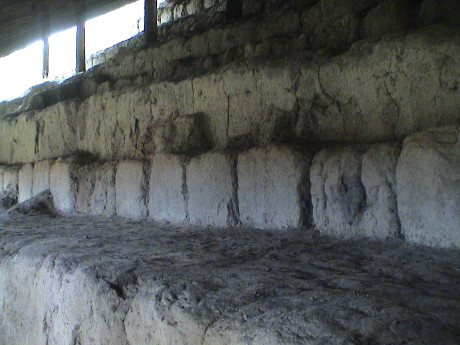 Some of the
mound edges have been excavated revealing Cangahua block terraces
around the pyramids. We hope to find something like this at Loma
Sandoval. The rest of the pyramids are filled with dirt with the tops
covered in baked clay with signs of postholes indicating that wooden
structures were built on top. Some of them also have trench like
features that might have any number of uses.
Some of the
mound edges have been excavated revealing Cangahua block terraces
around the pyramids. We hope to find something like this at Loma
Sandoval. The rest of the pyramids are filled with dirt with the tops
covered in baked clay with signs of postholes indicating that wooden
structures were built on top. Some of them also have trench like
features that might have any number of uses.
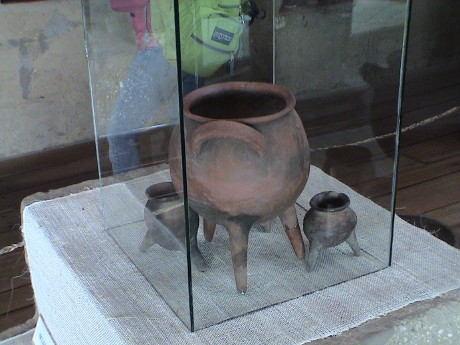 This is a sample of a
three-legged pot that was uncovered at Cochasqui. We've been finding
pieces of pots like these all over the Molinoloma and Loma Sandoval
sites, but nothing that is even nearly whole.
This is a sample of a
three-legged pot that was uncovered at Cochasqui. We've been finding
pieces of pots like these all over the Molinoloma and Loma Sandoval
sites, but nothing that is even nearly whole.
 As we were
leaving the site, the llamas started to migrate over to where we were,
apparently expecting a handout from us in the form of salt. The whole
bunch must have come over. It was not obvious while we were touring the
site how many that there were. Maybe a third of the total show in this
picture.
As we were
leaving the site, the llamas started to migrate over to where we were,
apparently expecting a handout from us in the form of salt. The whole
bunch must have come over. It was not obvious while we were touring the
site how many that there were. Maybe a third of the total show in this
picture.
 Somebody
brought a salt shaker. Sandy put some in her hand and a llama was happy
to relieve her of it. She was squealing like a little kid as the llama
was helping himself.
Somebody
brought a salt shaker. Sandy put some in her hand and a llama was happy
to relieve her of it. She was squealing like a little kid as the llama
was helping himself.
One the way back from Cochasqui, I was watching the fuel prices.
Premium is basically $2,05, regular is $1.55 and diesel is $1.05 per
gallon. I originally thought that the prices were per liter but Ecuador
is an oil exporter and fuel is relatively cheap here.
We got off the bus in Cayambe and again went to the Gran Aki to buy
some supplies. The bus terminal is only a couple of blocks from the
Gran Aki and we figured out that if you get on the bus ready to leave,
you'll be standing. This time, we waited for a new bus to come in and
unload and then quickly got on before it filled so that we got seats
near the front and didn't have to stand and then work our way through
the crowd to get to the front to get off again. This is the hot setup
if you are not in a hurry. The drivers basically wait at the terminal
to absolutely fill the bus to SRO capacity before they start their
trip. You either get a seat and wait or get on a bus ready to leave and
stand.
Monday, July 6, 2009, Hacienda Guachala, Ecuador, about 1640 ECT
(GMT -6)
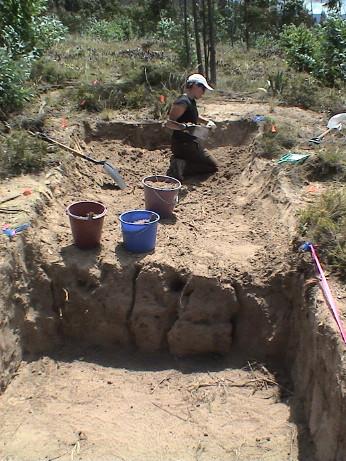 The weekend is over and it's
back to work. Sandy worked on ArcGIS in the lab all day. I went back to
Loma Sandoval to do more digging.
The weekend is over and it's
back to work. Sandy worked on ArcGIS in the lab all day. I went back to
Loma Sandoval to do more digging.
This is Kalli working on unit 4 trying to find a terrace wall. We
didn't find it. However, the formations in the shadow that the
directors thought might be the wall were proved not to be. The stuff
was just compacted dirt and once wet, it just falls apart. It would not
have withstood a single hard rain, much less 500 years in the
weather.
However, at unit 3 about 10 meters away, they did find what appears
to be part of a wall. It might even be a corner. If we project that row
of stones back to our dig, we'd have to dig 4 more meters (in the
direction away in this photo) and go quite deep to find it.
Since my back won't let me pick axe or shovel for long I spent all
morning carrying buckets of dirt excavated from unit 4 to a dump pile 6
or 7 meters away. We didn't sift this dirt as we expect that all the
artifacts found don't have much context anyway as a lot of dirt had
been moved to bury the site and the artifacts moved along with it. The
Ecuadorian worker that we hired to do this for us didn't show up.
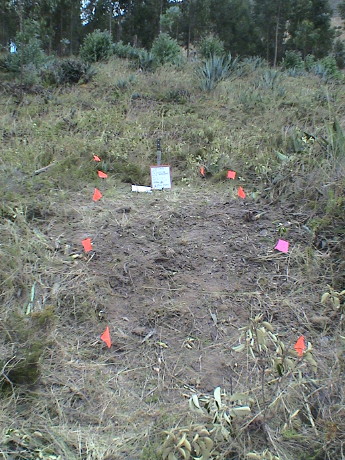 After lunch, I moved
to unit 1 which was a search for residential structures. That unit
turned out to be a bust. Nothing of interest was found so that the unit
was closed.
After lunch, I moved
to unit 1 which was a search for residential structures. That unit
turned out to be a bust. Nothing of interest was found so that the unit
was closed.
Instead of digging more in unit 1, a new unit, unit 5, was opened
just uphill. This unit is a 1 x 4 meter cut through a mound. The mound
started as an agave covered lump. The other Ecuadorian worker we hired
did show up and he made short work of the agave with a pickaxe. We
started digging that unit shortly before quitting time. We're not
sifting there either, so the back dirt is being carried in buckets to a
pile about 10 meters away. It can be sifted later if it is deemed
necessary.
We had more people that could fit in the little pickup trucks at the
site so it took two loads to get all of them up and down again. Chad
needed the truck during the day so that we shuttled the truck back and
forth. I drove the last load back and I came home dirty and tired.
Last night, I spent some time on Google Maps and Google Earth trying
to find a better satellite image of the Hacienda. The road that the
Hacienda is on isn't even on the maps, nor is the town of Cangahua.
Even after finding the area where the Hacienda was in the satellite
images was not fruitful as the area is covered in clouds. The actual
location of the Hacienda is a little northeast of the pin in the lead
photo.
Tuesday, July 7, 2009, Hacienda Guachala, Ecuador, about 1700 ECT
(GMT -6)
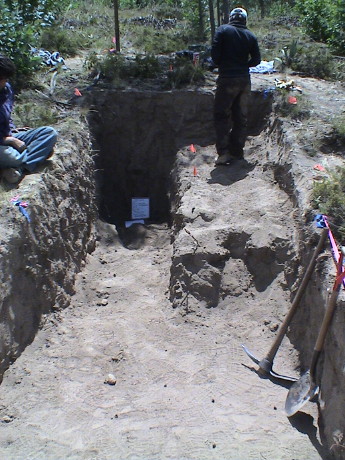 Today, I was back at
Loma Sandoval trying to find the terraces around a temple. We didn't
find them today. Instead of digging the whole unit out, we elected to
just dig to the back in half of the unit. This is the unit closing
photo. That back wall is about 1.5 meters high. I think that we have to
push the wall back another 4 meters before we will find the steps but I
am pretty sure that we will actually find them after a significant
amount of work.
Today, I was back at
Loma Sandoval trying to find the terraces around a temple. We didn't
find them today. Instead of digging the whole unit out, we elected to
just dig to the back in half of the unit. This is the unit closing
photo. That back wall is about 1.5 meters high. I think that we have to
push the wall back another 4 meters before we will find the steps but I
am pretty sure that we will actually find them after a significant
amount of work.
In unit 3 down the hill a little ways, they found another row of
steps and some signs that there might be TWO structures, one of much
rougher construction covering the other.
 To continue pushing
into the area of the terraces, we opened another unit tacked on to unit
4. This is unit 6 at the surface. It is 1 meter wide by 5 meters long.
We'll cut a trench up to 2 meters deep at the back until we find
something.... or not.
To continue pushing
into the area of the terraces, we opened another unit tacked on to unit
4. This is unit 6 at the surface. It is 1 meter wide by 5 meters long.
We'll cut a trench up to 2 meters deep at the back until we find
something.... or not.
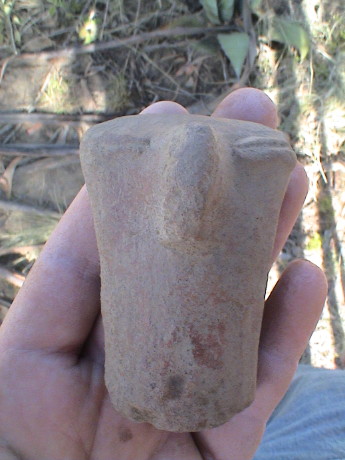 As we were breaking up the
surface of the first 3 meters of unit 6 to a depth of 15 cm or so,
Kalli spotted this artifact laying in the dug up dirt. It is probably
Inca although there is some opinion that it may be pre-Inka. We believe
that it is a stylized llama head that is broken off some larger piece
of pottery. Features like these were often attached at the top of a pot
to allow a rope sling to be tied to the pot.
As we were breaking up the
surface of the first 3 meters of unit 6 to a depth of 15 cm or so,
Kalli spotted this artifact laying in the dug up dirt. It is probably
Inca although there is some opinion that it may be pre-Inka. We believe
that it is a stylized llama head that is broken off some larger piece
of pottery. Features like these were often attached at the top of a pot
to allow a rope sling to be tied to the pot.
Sandy spent the day in the lab working on ArcGIS. She has been able
to convert digital elevation models of Ecuador that she found on the
internet to a raster format and display them. The project REALLY wants
her to dig into this stuff so that she has been relieved from digging
duties and assigned to the lab. She says that she is liking this
arrangement a lot. In the meantime, I'm out in the field getting really
dirty.
The weather today was pretty much like every day. It varied between
hot and sunny to cold and windy with periods of rain scattered in
between. There were also periods of overcast still air, then the wind
would pick up for a while and then die again. These changes can happen
every few minutes.
Wednesday, July 8, 2009, Hacienda Guachala, Ecuador, about 1630 ECT
(GMT -6)
 Today was much the
same as yesterday, I was at Loma Sandoval and Sandy was in the lab.
Today was much the
same as yesterday, I was at Loma Sandoval and Sandy was in the lab.
These are the "steps" in unit 3 that we are trying to find in unit
6. We haven't found them yet though.
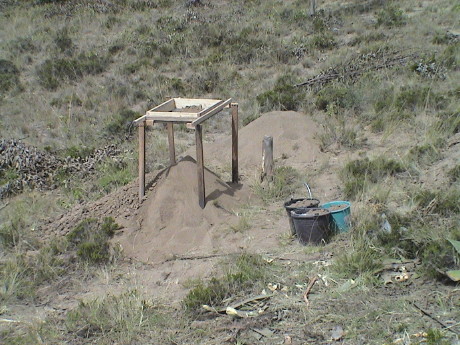 Since my back won't
let me pick or shovel I've been working the screen most of the day.
Initially, we weren't screening for artifacts. The excavated dirt was
simply piled up awaiting screening later if it was deemed necessary.
But since we found the ceramic llama, the plan changed. We screened ALL
of the dirt from unit 6 including that which was piled yesterday.
Since my back won't
let me pick or shovel I've been working the screen most of the day.
Initially, we weren't screening for artifacts. The excavated dirt was
simply piled up awaiting screening later if it was deemed necessary.
But since we found the ceramic llama, the plan changed. We screened ALL
of the dirt from unit 6 including that which was piled yesterday.
This picture was taken early in the day before we had much of a dirt
pile. By the end of the day, the pile was huge. We had to pull up the
screen legs several times to raise the whole assembly above the pile.
We also had to hoe out the pile to spread it out several times.
Normally, screening is the holdup. We run out of buckets to excavate
more dirt so that the excavation gets held up. However, we worked out a
method using three people that ran much more quickly. Two people worked
the screen and a third "bucket manager" refilled the screen with a new
load as soon as the screeners determined that there was nothing more to
find. The bucket manager would also collect any artifacts found and put
them into the appropriate bags while the screeners were working the
next load. This kept the screeners in place, undistracted and busy. We
also applied the "don't sweat the small stuff" rule where we would
shake out the dirt that fell through the screen and then examine the
result for a maximum of 5 seconds. If a potential artifact was not
large enough to be seen in that time, it was discarded too. Doing all
this stuff allowed us to keep up with the diggers.
We recently got eight new screens made by a carpenter up in
Cangahua. They cost the project $15 for all eight of them, materials
and labor. We need some new legs too as these four were the last ones I
could find and they were in the worst condition.
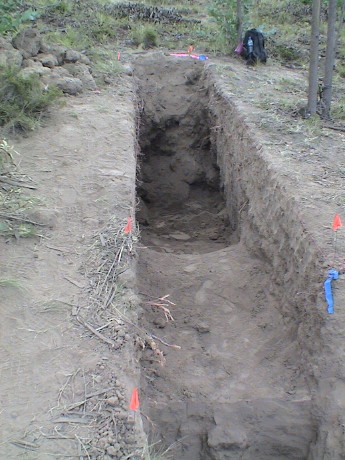 By the end
of the workday, this is what unit 6 looked like. We still haven't found
the steps at the end of the unit but we may have another half a meter
to dig assuming that the steps actually extended this far.
By the end
of the workday, this is what unit 6 looked like. We still haven't found
the steps at the end of the unit but we may have another half a meter
to dig assuming that the steps actually extended this far.
Thursday, July 9, 2009, Hacienda Guachala, Ecuador, about 1700 ECT
(GMT -6)
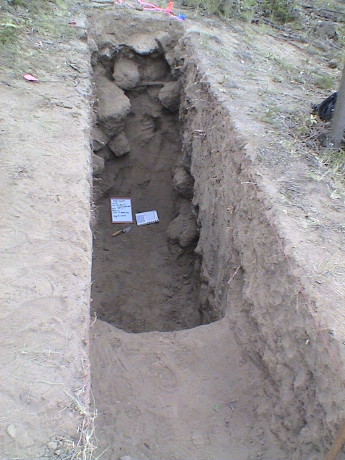 About mid
day today, we opened a new "level" in the unit. A level is defined when
there is a soil change. This indicates that the stuff above is probably
different from the stuff below. In our case, the change was that the
soil became more compacted and somewhat harder. We still hadn't found a
continuation of the stone wall from unit 3.
About mid
day today, we opened a new "level" in the unit. A level is defined when
there is a soil change. This indicates that the stuff above is probably
different from the stuff below. In our case, the change was that the
soil became more compacted and somewhat harder. We still hadn't found a
continuation of the stone wall from unit 3.
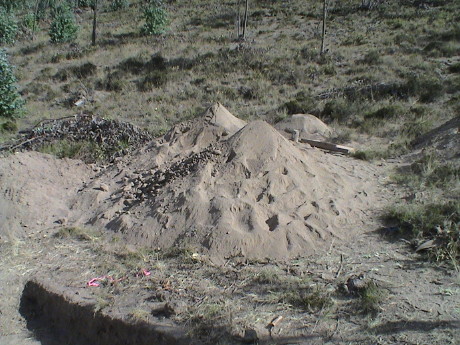 By quitting
time, our dirt pile had grown very large. In the morning, we broke down
and spread the pile from yesterday to allow a larger working surface on
top. We set up two screens, hence the two peaks of dirt. The second
screen allowed the screeners to work at a more sane pace and still keep
up with the diggers.
By quitting
time, our dirt pile had grown very large. In the morning, we broke down
and spread the pile from yesterday to allow a larger working surface on
top. We set up two screens, hence the two peaks of dirt. The second
screen allowed the screeners to work at a more sane pace and still keep
up with the diggers.
When we quit for the day, our "pit of despair" was about 2.5 meters
deep, well deep enough to expose the wall if it was there. We can only
conclude that the wall probably doesn't extend as far as our unit, at
least in the same form. However, we were still finding pottery, some in
pretty big pieces, all the way to the bottom.
Friday, July 10, 2009, Hacienda Guachala, Ecuador, about 1530 ECT
(GMT -6)
It took all morning to "clean up" and close unit 6. The final trench
is 2.2 meters deep. It might seem odd to have to clean up dirt, but
procedure calls out for well scraped vertical walls and no debris on
the floor. We also had to map the walls, that is to draw 1:20 scale
drawing of any features, such as rocks, that are left in the walls.
This is because on Monday, we are going to extend the unit 2 more
meters to the west, but only about 1 meter deep.
 I've been
going to Loma Sandoval for over a week now and this is the route that
I've settled on to get there as I was driving many of those days. I go
north toward the Pan American Highway, but I turn on to the old
railroad right of way, which is now a good dirt road, for much of the
distance to avoid having to drive on the highway and all the crazy
drivers there. We get to a deep ravine and then turn up a poor dirt
road to the south west corner of the site. The barbed wire fence is
down there so it is easy to get onto the site. We have permission to be
there. The crew then walks down the hill a little ways to the various
unit locations.
I've been
going to Loma Sandoval for over a week now and this is the route that
I've settled on to get there as I was driving many of those days. I go
north toward the Pan American Highway, but I turn on to the old
railroad right of way, which is now a good dirt road, for much of the
distance to avoid having to drive on the highway and all the crazy
drivers there. We get to a deep ravine and then turn up a poor dirt
road to the south west corner of the site. The barbed wire fence is
down there so it is easy to get onto the site. We have permission to be
there. The crew then walks down the hill a little ways to the various
unit locations.
This coming weekend is a weekend off so that folks can go off on
sightseeing trips. Students can only go places that senior staff is
going too. There are three trips on the schedule, one to a city of
Mindo on the costal side of the Andies in the low level rain forest, one to a city even
further up the coast, Puerto Quito and one to back to Otavalo. Sandy
and I are going on the Otavalo trip because Sandy wants to go back
there to buy more loot. Further the other two trips are to malaria risk
areas. We have the anti-malarial drugs but I'd rather not risk it.
It will be an overnight trip this time. We are traveling light so
that I don't expect to create another entry into this trip log until we
get back.
[ Vacation Diaries ] [ Pambamarca 2009 ] [ Previous Page ] [ Next Page ]
© 2009 George Schreyer
Created 5 Jul 09
Last Updated July 11, 2009
 Today, the group took a
field trip to Cochasqui, a site with pre-Inka terraced pyramids. it is
not known exactly what went on on these flat topped pyramids, but the
reasons could be ceremonial, religious, astrological or just about
anything else. The existing structures just look like dirt mounds now
with an obvious ramp leading up to one edge. This is what we are
looking for at Loma Sandoval but our site has been modified by
bulldozer in recent times and doesn't stand out nearly so clearly.
Today, the group took a
field trip to Cochasqui, a site with pre-Inka terraced pyramids. it is
not known exactly what went on on these flat topped pyramids, but the
reasons could be ceremonial, religious, astrological or just about
anything else. The existing structures just look like dirt mounds now
with an obvious ramp leading up to one edge. This is what we are
looking for at Loma Sandoval but our site has been modified by
bulldozer in recent times and doesn't stand out nearly so clearly. The shapes of the pyramids are
still pretty clear, even after 500 years. Most of them have nothing
inside, all the action apparently happened on top. A few have burial
chambers in them. There are also many older rounded burial mounds on
the site.
The shapes of the pyramids are
still pretty clear, even after 500 years. Most of them have nothing
inside, all the action apparently happened on top. A few have burial
chambers in them. There are also many older rounded burial mounds on
the site. The site is also well
stocked with llama and this is the reason why. These two are busy
making little llamas.
The site is also well
stocked with llama and this is the reason why. These two are busy
making little llamas. Some of the
mound edges have been excavated revealing Cangahua block terraces
around the pyramids. We hope to find something like this at Loma
Sandoval. The rest of the pyramids are filled with dirt with the tops
covered in baked clay with signs of postholes indicating that wooden
structures were built on top. Some of them also have trench like
features that might have any number of uses.
Some of the
mound edges have been excavated revealing Cangahua block terraces
around the pyramids. We hope to find something like this at Loma
Sandoval. The rest of the pyramids are filled with dirt with the tops
covered in baked clay with signs of postholes indicating that wooden
structures were built on top. Some of them also have trench like
features that might have any number of uses. This is a sample of a
three-legged pot that was uncovered at Cochasqui. We've been finding
pieces of pots like these all over the Molinoloma and Loma Sandoval
sites, but nothing that is even nearly whole.
This is a sample of a
three-legged pot that was uncovered at Cochasqui. We've been finding
pieces of pots like these all over the Molinoloma and Loma Sandoval
sites, but nothing that is even nearly whole. As we were
leaving the site, the llamas started to migrate over to where we were,
apparently expecting a handout from us in the form of salt. The whole
bunch must have come over. It was not obvious while we were touring the
site how many that there were. Maybe a third of the total show in this
picture.
As we were
leaving the site, the llamas started to migrate over to where we were,
apparently expecting a handout from us in the form of salt. The whole
bunch must have come over. It was not obvious while we were touring the
site how many that there were. Maybe a third of the total show in this
picture. Somebody
brought a salt shaker. Sandy put some in her hand and a llama was happy
to relieve her of it. She was squealing like a little kid as the llama
was helping himself.
Somebody
brought a salt shaker. Sandy put some in her hand and a llama was happy
to relieve her of it. She was squealing like a little kid as the llama
was helping himself. The weekend is over and it's
back to work. Sandy worked on ArcGIS in the lab all day. I went back to
Loma Sandoval to do more digging.
The weekend is over and it's
back to work. Sandy worked on ArcGIS in the lab all day. I went back to
Loma Sandoval to do more digging. After lunch, I moved
to unit 1 which was a search for residential structures. That unit
turned out to be a bust. Nothing of interest was found so that the unit
was closed.
After lunch, I moved
to unit 1 which was a search for residential structures. That unit
turned out to be a bust. Nothing of interest was found so that the unit
was closed. Today, I was back at
Loma Sandoval trying to find the terraces around a temple. We didn't
find them today. Instead of digging the whole unit out, we elected to
just dig to the back in half of the unit. This is the unit closing
photo. That back wall is about 1.5 meters high. I think that we have to
push the wall back another 4 meters before we will find the steps but I
am pretty sure that we will actually find them after a significant
amount of work.
Today, I was back at
Loma Sandoval trying to find the terraces around a temple. We didn't
find them today. Instead of digging the whole unit out, we elected to
just dig to the back in half of the unit. This is the unit closing
photo. That back wall is about 1.5 meters high. I think that we have to
push the wall back another 4 meters before we will find the steps but I
am pretty sure that we will actually find them after a significant
amount of work. To continue pushing
into the area of the terraces, we opened another unit tacked on to unit
4. This is unit 6 at the surface. It is 1 meter wide by 5 meters long.
We'll cut a trench up to 2 meters deep at the back until we find
something.... or not.
To continue pushing
into the area of the terraces, we opened another unit tacked on to unit
4. This is unit 6 at the surface. It is 1 meter wide by 5 meters long.
We'll cut a trench up to 2 meters deep at the back until we find
something.... or not. As we were breaking up the
surface of the first 3 meters of unit 6 to a depth of 15 cm or so,
Kalli spotted this artifact laying in the dug up dirt. It is probably
Inca although there is some opinion that it may be pre-Inka. We believe
that it is a stylized llama head that is broken off some larger piece
of pottery. Features like these were often attached at the top of a pot
to allow a rope sling to be tied to the pot.
As we were breaking up the
surface of the first 3 meters of unit 6 to a depth of 15 cm or so,
Kalli spotted this artifact laying in the dug up dirt. It is probably
Inca although there is some opinion that it may be pre-Inka. We believe
that it is a stylized llama head that is broken off some larger piece
of pottery. Features like these were often attached at the top of a pot
to allow a rope sling to be tied to the pot. Today was much the
same as yesterday, I was at Loma Sandoval and Sandy was in the lab.
Today was much the
same as yesterday, I was at Loma Sandoval and Sandy was in the lab. Since my back won't
let me pick or shovel I've been working the screen most of the day.
Initially, we weren't screening for artifacts. The excavated dirt was
simply piled up awaiting screening later if it was deemed necessary.
But since we found the ceramic llama, the plan changed. We screened ALL
of the dirt from unit 6 including that which was piled yesterday.
Since my back won't
let me pick or shovel I've been working the screen most of the day.
Initially, we weren't screening for artifacts. The excavated dirt was
simply piled up awaiting screening later if it was deemed necessary.
But since we found the ceramic llama, the plan changed. We screened ALL
of the dirt from unit 6 including that which was piled yesterday. By the end
of the workday, this is what unit 6 looked like. We still haven't found
the steps at the end of the unit but we may have another half a meter
to dig assuming that the steps actually extended this far.
By the end
of the workday, this is what unit 6 looked like. We still haven't found
the steps at the end of the unit but we may have another half a meter
to dig assuming that the steps actually extended this far. About mid
day today, we opened a new "level" in the unit. A level is defined when
there is a soil change. This indicates that the stuff above is probably
different from the stuff below. In our case, the change was that the
soil became more compacted and somewhat harder. We still hadn't found a
continuation of the stone wall from unit 3.
About mid
day today, we opened a new "level" in the unit. A level is defined when
there is a soil change. This indicates that the stuff above is probably
different from the stuff below. In our case, the change was that the
soil became more compacted and somewhat harder. We still hadn't found a
continuation of the stone wall from unit 3. By quitting
time, our dirt pile had grown very large. In the morning, we broke down
and spread the pile from yesterday to allow a larger working surface on
top. We set up two screens, hence the two peaks of dirt. The second
screen allowed the screeners to work at a more sane pace and still keep
up with the diggers.
By quitting
time, our dirt pile had grown very large. In the morning, we broke down
and spread the pile from yesterday to allow a larger working surface on
top. We set up two screens, hence the two peaks of dirt. The second
screen allowed the screeners to work at a more sane pace and still keep
up with the diggers. I've been
going to Loma Sandoval for over a week now and this is the route that
I've settled on to get there as I was driving many of those days. I go
north toward the Pan American Highway, but I turn on to the old
railroad right of way, which is now a good dirt road, for much of the
distance to avoid having to drive on the highway and all the crazy
drivers there. We get to a deep ravine and then turn up a poor dirt
road to the south west corner of the site. The barbed wire fence is
down there so it is easy to get onto the site. We have permission to be
there. The crew then walks down the hill a little ways to the various
unit locations.
I've been
going to Loma Sandoval for over a week now and this is the route that
I've settled on to get there as I was driving many of those days. I go
north toward the Pan American Highway, but I turn on to the old
railroad right of way, which is now a good dirt road, for much of the
distance to avoid having to drive on the highway and all the crazy
drivers there. We get to a deep ravine and then turn up a poor dirt
road to the south west corner of the site. The barbed wire fence is
down there so it is easy to get onto the site. We have permission to be
there. The crew then walks down the hill a little ways to the various
unit locations.